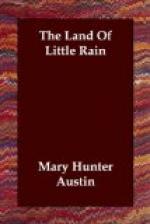The lake is the eye of the mountain, jade green, placid, unwinking, also unfathomable. Whatever goes on under the high and stony brows is guessed at. It is always a favorite local tradition that one or another of the blind lakes is bottomless. Often they lie in such deep cairns of broken boulders that one never gets quite to them, or gets away unhurt. One such drops below the plunging slope that the Kearsarge trail winds over, perilously, nearing the pass. It lies still and wickedly green in its sharp-lipped cup, and the guides of that region love to tell of the packs and pack animals it has swallowed up.
But the lakes of Oppapago are perhaps not so deep, less green than gray, and better befriended. The ousel haunts them, while still hang about their coasts the thin undercut drifts that never quite leave the high altitudes. In and out of the bluish ice caves he flits and sings, and his singing heard from above is sweet and uncanny like the Nixie’s chord. One finds butterflies, too, about these high, sharp regions which might be called desolate, but will not by me who love them. This is above timber-line but not too high for comforting by succulent small herbs and golden tufted grass. A granite mountain does not crumble with alacrity, but once resolved to soil makes the best of it. Every handful of loose gravel not wholly water leached affords a plant footing, and even in such unpromising surroundings there is a choice of locations. There is never going to be any communism of mountain herbage, their affinities are too sure. Full in the runnels of snow water on gravelly, open spaces in the shadow of a drift, one looks to find buttercups, frozen knee-deep by night, and owning no desire but to ripen their fruit above the icy bath. Soppy little plants of the portulaca and small, fine ferns shiver under the drip of falls and in dribbling crevices. The bleaker the situation, so it is near a stream border, the better the cassiope loves it. Yet I have not found it on the polished glacier slips, but where the country rock cleaves and splinters in the high windy headlands that the wild sheep frequents, hordes and hordes of the white bells swing over matted, mossy foliage. On Oppapago, which is also called Sheep Mountain, one finds not far from the beds of cassiope the ice-worn, stony hollows where the bighorns cradle their young. These are above the wolf’s quest and the eagle’s wont, and though the heather beds are softer, they




